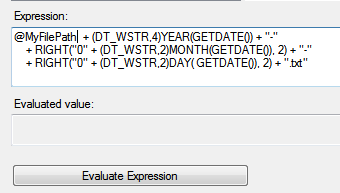Over the last week I have done several sessions either for the Pragmatic Works Free Training online or at SQL Saturday. It has been a lot of fun, so thank you to everyone who has come out and hopefully learned something from one of the sessions I have done. So, I mentioned a couple things I was going to do, one of which is post a quick recap and sample package from the Expressions and Variables session. So here that is. The other will come next week when I post some same situations and data sets that need to be cleaned up so you can try out using expressions to clean them up. So the wrap up/followup/summary…
- Expressions and Variables are NOT independent, they can and often are used together
- If there is a user editable property for a task, then it is highly likely that you can put an expression on it
- Configurations are evaluated at package run time, a KEY DIFFERENT for expressions is that they are evaluated as they are come across in the package. Consequently they can be evaluated many times if they are inside of a for each loop for instance
- Variables can be evaluated as an expressions, just be sure to set the property to use the expression to TRUE, again not sure why they even make you do that
- I’m currently listening to the new Blink-182 album, Neighborhoods, that came out this week and I saw them in Tampa Saturday after presenting at SQL Saturday. IT WAS AWESOME!! That has nothing to do with this, just checking to see if you are skimming or reading everything in this blog
- Just a couple of places you can use expressions: variables, precedence constraints, connection managers, tasks, data flow transforms like the conditional split and derived column
- Most common use for expressions in the data flow is probably for data cleansing, but then again that is also a case by case sort of thing
- If you want to do things like append the date to the end of a file it can be done, but remember to cast the date parts as a string value and save the expression someplace since it will likely be used again in the future and it is pretty messy
- Current Date in the format of YYYY-MM-DD
- (DT_WSTR,4)YEAR( GETDATE() ) + “-” + RIGHT(“0″ + (DT_WSTR,2)MONTH( GETDATE() ), 2) + “-” + RIGHT(“0″ + (DT_WSTR,2)DAY(GETDATE()), 2)
- Separate the file name from the full path
- RIGHT(@FilePathVariable, FINDSTRING( REVERSE(@FilePathVariable), “\\”, 1 ) – 1 )
- File Path with current date
- “C:\\SampleFile” + (DT_WSTR,4)YEAR(DATEADD(“dd”, -1, GETDATE())) + “-” + RIGHT(“0″ + (DT_WSTR,2)MONTH(DATEADD(“dd”, -1, GETDATE())), 2) + “-” + RIGHT(“0″ + (DT_WSTR,2)DAY(DATEADD(“dd”, -1, GETDATE())), 2) + “.txt”
- Convert Filing Date (Column in a sample data set in format MMDDYYYY) to an actual date
- (DT_DBDATE)(SUBSTRING(FillingDate,1,2) + “/” + SUBSTRING(FillingDate,3,2) + “/” + SUBSTRING(FillingDate,5,4))
- Pull back just the year from a date column
- YEAR(Columnname)
- Replace the # In Address Line 2 with an empty string
- REPLACE(AddressLine2,”#”,”")
- Replace the Word ROAD With RD
- REPLACE(AddressLine1,”ROAD”,”RD”)
- Replace blank country with NULL
- TRIM(Country) == “” ? NULL(DT_WSTR,2) : Country
- Replace blank country with Unknown
- TRIM(Country) == “” ? “Unknown” : Country
- Conditional Split Examples
- Missing Zip TRIM(ZipCode) == “”
- Missing State TRIM(State) == “”
- Missing Either TRIM(State) == “” || TRIM(ZipCode) == “”



